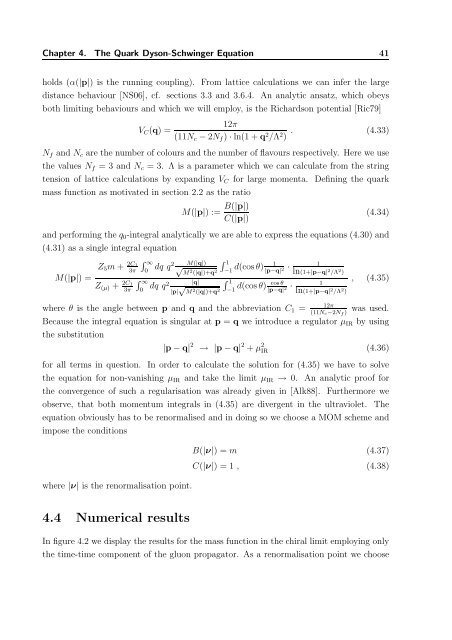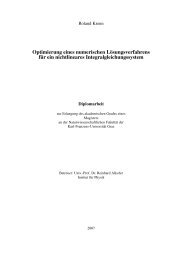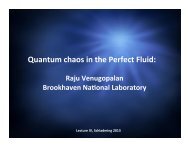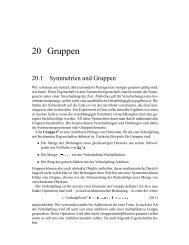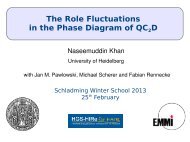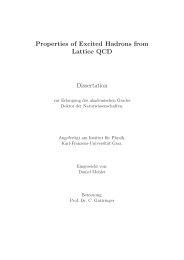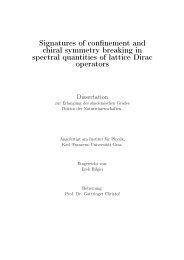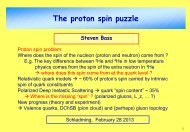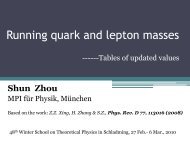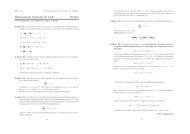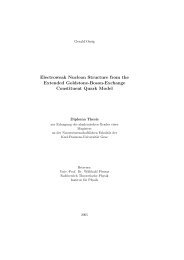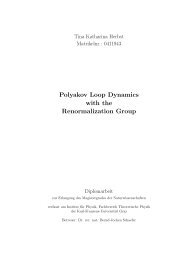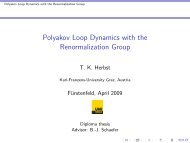The QCD Quark Propagator in Coulomb Gauge and - Institut für Physik
The QCD Quark Propagator in Coulomb Gauge and - Institut für Physik
The QCD Quark Propagator in Coulomb Gauge and - Institut für Physik
You also want an ePaper? Increase the reach of your titles
YUMPU automatically turns print PDFs into web optimized ePapers that Google loves.
Chapter 4. <strong>The</strong> <strong>Quark</strong> Dyson-Schw<strong>in</strong>ger Equation 41<br />
holds (α(|p|) is the runn<strong>in</strong>g coupl<strong>in</strong>g). From lattice calculations we can <strong>in</strong>fer the large<br />
distance behaviour [NS06], cf. sections 3.3 <strong>and</strong> 3.6.4. An analytic ansatz, which obeys<br />
both limit<strong>in</strong>g behaviours <strong>and</strong> which we will employ, is the Richardson potential [Ric79]<br />
V C (q) =<br />
12π<br />
(11N c − 2N f ) · ln(1 + q 2 /Λ 2 ) . (4.33)<br />
N f <strong>and</strong> N c are the number of colours <strong>and</strong> the number of flavours respectively. Here we use<br />
the values N f = 3 <strong>and</strong> N c = 3. Λ is a parameter which we can calculate from the str<strong>in</strong>g<br />
tension of lattice calculations by exp<strong>and</strong><strong>in</strong>g V C for large momenta. Def<strong>in</strong><strong>in</strong>g the quark<br />
mass function as motivated <strong>in</strong> section 2.2 as the ratio<br />
M(|p|) := B(|p|)<br />
C(|p|)<br />
(4.34)<br />
<strong>and</strong> perform<strong>in</strong>g the q 0 -<strong>in</strong>tegral analytically we are able to express the equations (4.30) <strong>and</strong><br />
(4.31) as a s<strong>in</strong>gle <strong>in</strong>tegral equation<br />
M(|p|) =<br />
Z 5 m + 2C 1<br />
3π<br />
Z (µ) + 2C 1<br />
3π<br />
∫ ∞<br />
0<br />
dq q 2 M(|q|)<br />
√M 2 (|q|)+q 2 ∫ 1<br />
−1 d(cosθ) 1<br />
|p−q| 2 ·<br />
1<br />
ln(1+|p−q| 2 /Λ 2 )<br />
∫ ∞<br />
dq q<br />
0 2 √ |q|<br />
∫ 1 cos θ 1<br />
d(cosθ) ·<br />
|p| M 2 (|q|)+q 2 −1 |p−q| 2 ln(1+|p−q| 2 /Λ 2 )<br />
, (4.35)<br />
where θ is the angle between p <strong>and</strong> q <strong>and</strong> the abbreviation C 1 =<br />
12π<br />
(11N c−2N f )<br />
was used.<br />
Because the <strong>in</strong>tegral equation is s<strong>in</strong>gular at p = q we <strong>in</strong>troduce a regulator µ IR by us<strong>in</strong>g<br />
the substitution<br />
|p − q| 2 → |p − q| 2 + µ 2 IR (4.36)<br />
for all terms <strong>in</strong> question. In order to calculate the solution for (4.35) we have to solve<br />
the equation for non-vanish<strong>in</strong>g µ IR <strong>and</strong> take the limit µ IR → 0. An analytic proof for<br />
the convergence of such a regularisation was already given <strong>in</strong> [Alk88]. Furthermore we<br />
observe, that both momentum <strong>in</strong>tegrals <strong>in</strong> (4.35) are divergent <strong>in</strong> the ultraviolet. <strong>The</strong><br />
equation obviously has to be renormalised <strong>and</strong> <strong>in</strong> do<strong>in</strong>g so we choose a MOM scheme <strong>and</strong><br />
impose the conditions<br />
where |ν| is the renormalisation po<strong>in</strong>t.<br />
B(|ν|) = m (4.37)<br />
C(|ν|) = 1 , (4.38)<br />
4.4 Numerical results<br />
In figure 4.2 we display the results for the mass function <strong>in</strong> the chiral limit employ<strong>in</strong>g only<br />
the time-time component of the gluon propagator. As a renormalisation po<strong>in</strong>t we choose


